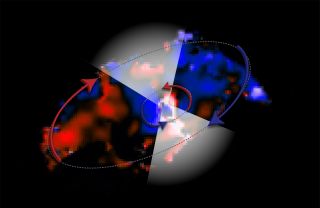How Ancient Black Holes May Have Grown So Quickly in the Early Universe – Space.com
Researchers have discovered streams of gas rotating in opposite directions around a distant, supermassive black hole. This finding offers new clues about how black holes grew so rapidly in the early universe.
This supermassive black hole lies at the heart of the spiral galaxy NGC 1068, or Messier 77, which is located approximately 47 million light-years from Earth. This black hole is hidden within a thick doughnut-shaped cloud of dust and gas.
Using the Atacama Large Millimeter/submillimeter Array (ALMA) in Chile, astronomers found that the black hole is actually surrounded by two counter-rotating disks of gas. The inner disk spans 2 to 4 light-years and rotates in the same direction as the galaxy, while the outer disk spans 4 to 22 light-years and spins in the opposite direction, according to a statement from ALMA.
“Thanks to the spectacular resolution of ALMA, we measured the movement of gas in the inner orbits around the black hole,” lead author Violette Impellizzeri, an astronomer from the National Radio Astronomy Observatory (NRAO) who works at ALMA, said in the statement. “Surprisingly, we found two disks of gas rotating in opposite directions.”
Earlier studies of NGC 1068 revealed that the black hole has a monster appetite. Gas from the region surrounding the black hole, also known as the accretion disk, falls into the black hole, is superheated and then is thrown back out into space at incredibly high speeds. This process makes it difficult for optical telescopes to see through the region around the black hole. Gas in counter-rotating disks is believed to be more unstable than gas in a single rotating accretion disk, according to the statement. Therefore, gas in counter-rotating disks is believed to fall into a black hole faster, which could help to explain how some supermassive black holes grow so quickly, Impellizzeri said.
Using ALMA’s extremely capable zoom lens, astronomers were able to observe the molecular gas around the black hole in NGC 1068 in great detail. cPreviously, counter-rotation has only been observed in galaxies thousands of light-years away from the galactic center.

This ALMA image shows two disks of gas moving in opposite directions around a black hole in the galaxy NGC 1068. The colors represent the motion of the gas: blue is material moving toward us, red is moving away. The white triangles show the accelerated gas that is expelled from the inner disk – forming a thick, obscuring cloud around the black hole.
(Image credit: ALMA (ESO/NAOJ/NRAO), V. Impellizzeri; NRAO/AUI/NSF, S. Dagnello.)
However, in this study, the counter-rotation around NGC 1068 was seen occurring on a much smaller scale, only tens of light-years from the central black hole, the researchers said.
“We did not expect to see this because gas falling into a black hole would normally spin around it in only one direction,” Impellizzeri said. “Something must have disturbed the flow because it is impossible for a part of the disk to start rotating backward all on its own.”
To explain the backward flow of gas observed in NGC 1068, the astronomers suggest that gas clouds may have fallen out of the host galaxy or, alternatively, a small, passing galaxy on a counter-rotating orbit may be captured in the accretion disk, according to the statement.
While the outer disk currently appears to be in a stable orbit around the inner disk, the researchers expect that it will eventually fall onto the inner disk.
“The rotating streams of gas will collide and become unstable, and the disks will likely collapse in a luminous event as the molecular gas falls into the black hole,” co-author Jack Gallimore, a professor of physics and astronomy at Bucknell University in Lewisburg, Pennsylvania, said in the statement. “Unfortunately, we will not be there to witness the fireworks.”
These findings were published Oct. 14 in the Astrophysical Journal Letters.
Follow Samantha Mathewson @Sam_Ashley13. Follow us on Twitter @Spacedotcom and on Facebook.






